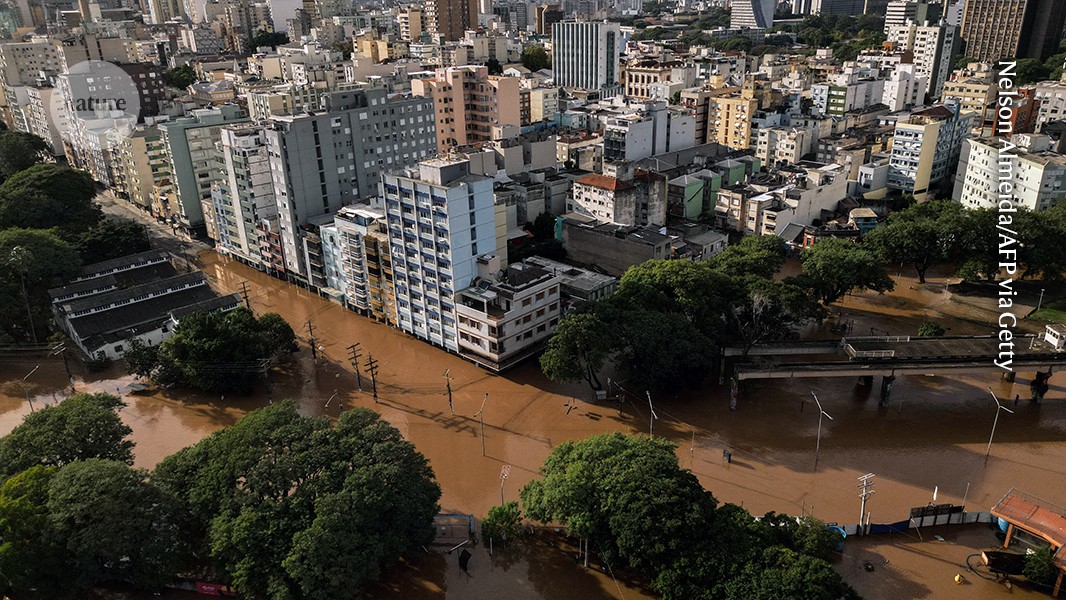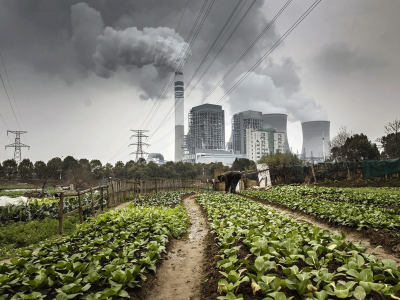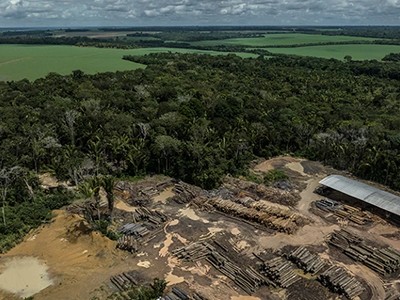Porto Alegre, Brazil
When the water started to surge from a maintenance hole in front of her house on a Saturday afternoon, Maria Margarete Jaskulski realized it was time to leave. Neighbours had warned her that flooding had already reached other parts of her neighbourhood in Porto Alegre, Brazil. In the rush to escape, she put a drawer containing her most valuable documents and keepsakes on top of her bed and then fled with her family and pets to a relative’s home across town.
Later that night, her daughter heard from neighbours that the water had filled most of their house. “I cried as if someone had died,” says Jaskulski.
The flood lingered for weeks, leaving a series of brown lines on the walls that marked the different water levels. It would be more than a month before she could return to a house filled with mud and debris. The furniture was ruined, and only the items placed on her bed were spared, the mattress having floated like a lifeboat.
Jaskulski is among the more than 2 million people affected by the devastating floods that hit Rio Grande do Sul, Brazil’s southernmost state, in April and May. The disaster, driven by a combination of torrential rains, climate change and infrastructure failures, affected 96% of the state’s cities, displacing more than 500,000 people and causing 183 deaths (see ‘Historic flooding’).

Sources: Flooding: DEE-SPGG; land cover: ESA, HydroSheds, OSM; GuaÍba river basin: I. Possantti et al. Preprint at https://zenodo.org/records/13227745 (2024)
It also took a huge toll on people’s mental health. When I met Jaskulski, three months after the water had first entered her house, the emotional strain was still evident, her eyes filling with tears as she recounted the experience. According to an online survey of residents across the state, 45% of respondents reported moderate to severe anxiety in the first month after the floods. Like Jaskulski, many also reported reactions associated with acute stress disorder, such as difficulty concentrating and derealization, a feeling of disconnection from reality.
“Given the number of people affected, we should expect a significant increase in mental-health disorders in the medium and long term,” says psychologist Christian Kristensen, coordinator of the Center for Study and Research in Trauma and Stress at the Pontifical Catholic University of Rio Grande do Sul in Porto Alegre.
A giant fund for climate disasters will soon open. Who should be paid first?
Such epidemics of trauma are becoming all too common as climate change boosts the number and severity of extreme weather-related disasters. This year alone has seen heatwaves in Europe, rain-caused landslides in India and typhoons in the Philippines. Although most of the attention after these disasters focuses on deaths and property damage, the events can trigger widespread mental-health problems that can last for years — a toll seen after Hurricane Katrina in the United States in 2005 (E. J. Raker et al. Soc. Sci. Med. 242, 112610; 2019).
Around 4.5 billion people are now vulnerable to extreme weather events, more than half of whom live below the poverty line. But there has been relatively little research on how to help people facing mental-health challenges as a result of climate disasters. This is especially true in low-and middle-income countries, which are most vulnerable to these crises. Lessons have started to emerge, however, from studies conducted immediately after the Rio Grande do Sul crisis, such as how community members can support each other during the initial response to a disaster to prevent trauma.
What’s happening here in Brazil could shape responses to future disasters worldwide, says Débora Noal, a psychologist who led the mental-health-response team for Brazil’s national health task force during the flood. “The size of the territory, the number of people affected, the number of people displaced from territories that will remain inhabited, is a sample of what will become increasingly common in the world.”
Rising waters
As heavy rains were battering Porto Alegre in May, many mental-health researchers from across Brazil were gathered at the city’s Federal University of Rio Grande do Sul (UFRGS). The meeting marked the launch of efforts to conduct the country’s first nationwide mental-health survey, a project led by Flavio Kapczinski, a psychiatrist at the university. There is currently no reliable estimate of the national prevalence of mental illness in the Brazilian population.
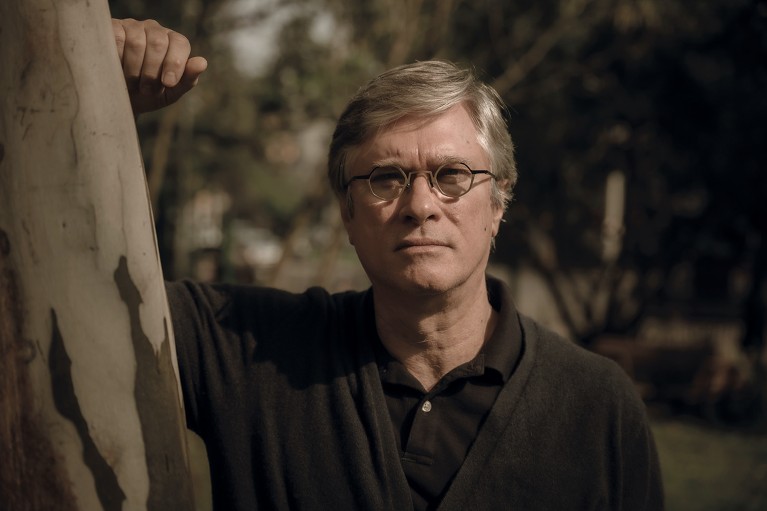
Psychiatrist Flavio Kapczinski emphasizes the need to tailor trauma prevention strategies to low- and middle-income countries.Credit: Marcio Pimenta for Nature
When news broke that the city’s airport had closed, the event’s organizers quickly evacuated participants who didn’t live in the town, sending them to the nearest functioning airport so that they could make their way home before the situation worsened. “It was a real scramble,” Kapczinski recalls.
The heavy rains lasted several days between late April and mid-May, pouring mainly in the Guaíba River basin, which supplies water to Porto Alegre, and several of its tributaries. In some areas of the state, nearly one metre of rain fell during a two-week span (see ‘Rainfall totals’).
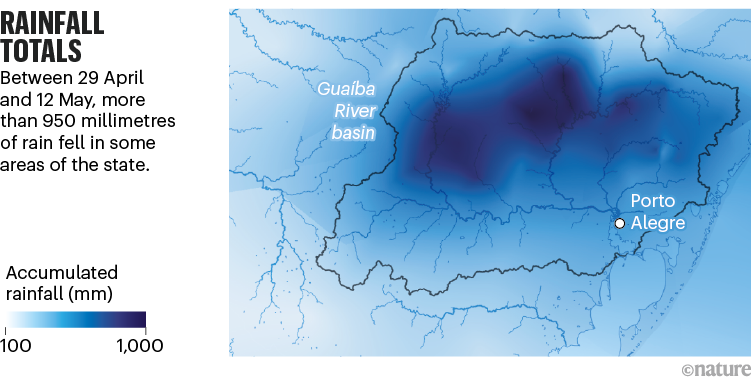
Source: N. Ramalho
“This was the biggest rainfall ever recorded in Brazil,” says Sofia Royer Moraes, an environmental engineer and hydrologist at the University of Taquari Valley in Lajeado.
The extraordinary rainfall was caused partly by an unusually strong collision between a warm air mass coming from central Brazil and a cold front streaming from the south. A rapid analysis by the World Weather Attribution initiative, which evaluates the influence of global warming on extreme weather events, found that human-induced climate change increased both the likelihood and the intensity of the event.
Is it too late to keep global warming below 1.5 °C? The challenge in 7 charts
Once the host researchers at the mental-health meeting in Rio Grande do Sul had helped to evacuate their colleagues, they were left to deal with the consequences of the flooding. Even those who didn’t have to flee their homes faced widespread shortages of clean water and electricity. But some began to leverage their expertise to assist with the response to the tragedy.
“In the first couple of weeks, we were concerned about the potential effects on the mental health of our patients during the emergency,” says Simone Hauck, a psychiatrist at UFRGS’s teaching hospital. She and her colleagues quickly developed a survey to measure acute stress, depression and anxiety, which they planned to deploy in the hospitals in which they worked. “But it quickly became clear to us that this impact would be enormous, affecting nearly all residents of the state,” she says.

Psychiatrist Simone Hauck launched an online survey to measure stress and anxiety symptoms after the disaster.Credit: Marcio Pimenta for Nature
In one sleepless night, Hauck wrote a proposal for a state-wide online survey, which was readily approved by her institution’s ethics committee. The results of the survey, which have been accepted for publication in Trends in Psychiatry and Psychotherapy, provided a snapshot of mental-health symptoms in the population during the acute phase of the disaster. More than 1,500 people responded to the survey between 10 May and 6 June, and 43% of them had been directly affected by the floods. In addition to anxiety and acute stress disorder, 42% reported having moderate to severe depression symptoms.
The results aligned with findings from other parts of the world. “The greater the socio-economic vulnerability, the more symptoms of anxiety, depression and burnout they reported,” Hauck says. She hopes that the findings could be used to help direct resources in other crises. Given how widespread the symptoms were, she says, the best strategy is to educate the population to help one another.
A flooded state
In the weeks that Jaskulski’s neighbourhood was flooded, she went back a few times to check on her house.“It didn’t even look like the same street,” she says. “That really affected me emotionally because it’s my home, I’ve lived there my whole life, and I built it with a lot of sacrifice.”
The clinic in which Jaskulski works to help people navigate the health-care system was spared by the flood waters, but remained closed for more than a month, because it was cut off entirely from its surroundings.
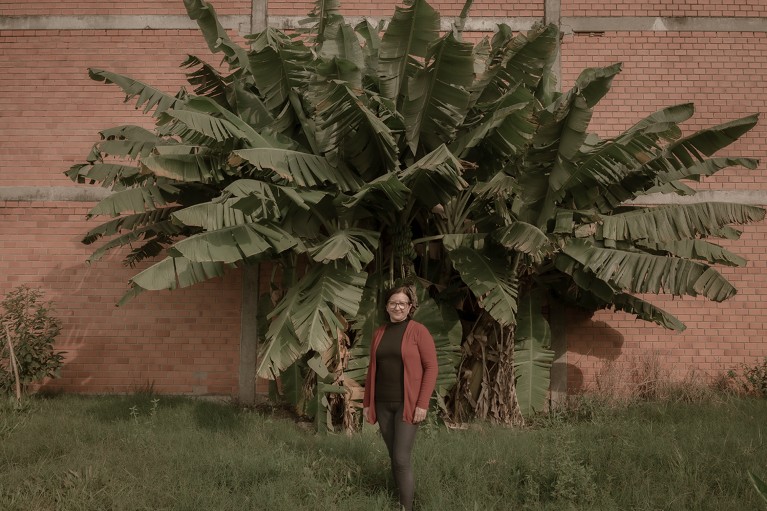
Community health worker Maria Margarete Jaskulski lost nearly all of her belongings after the water took over her house in May.Credit: Marcio Pimenta for Nature
In early August, after the clinic reopened, I met Jaskulski and other community-health workers as they planned their return to work, preparing to provide care and support for community members while dealing with their own losses. “When we come across someone who is suffering, all we can do is cry with them. Because now we are not just health-care professionals, we are also victims,” said Janete Pereira, one of the clinic’s community-health workers.
Clinical psychologist Anderson Nunes Jardim, who runs a private practice in Porto Alegre, continued holding online sessions with his patients while sheltering at his sister’s house; his own home was nearly submerged. “My patients were surprised that I was working,” he says. But he was in a safe place and knew he was needed.
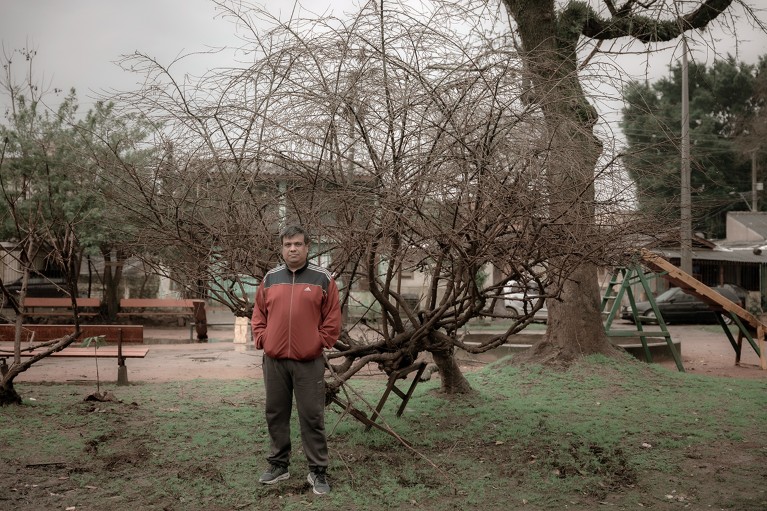
Clinical psychologist Anderson Nunes Jardim continued to see his patients even after his house in Porto Alegre was completely flooded.Credit: Marcio Pimenta for Nature
Nearly all his sessions in May and June focused on the flooding, he says. “Those who weren’t directly affected worked as volunteers and talked about how exhausting it was. Many brought up the fear of it happening again.”
Jardim’s mother, Jurema Nunes Jardim, who had been living at the same address for 58 years, had never seen anything like it. “I cried a lot. I would fall asleep and soon wake up thinking about all the things I had lost,” she says.
Most people going through a disaster will experience symptoms of distress, including anxiety, sadness, hopelessness, difficulty sleeping and fatigue. This is normal and, for most people, the symptoms will go away with time, according to the World Health Organization (WHO). But studies have pointed to actions that can prevent these from becoming long-term mental-health issues.
The first is ensuring that people have access to basic necessities such as shelter, water, food and safety. “Even more than providing access to psychologists and psychiatrists, what’s important is offering a sense of safety,” says Bruno Paz Mosqueiro, a psychiatrist at UFRGS’s teaching hospital.
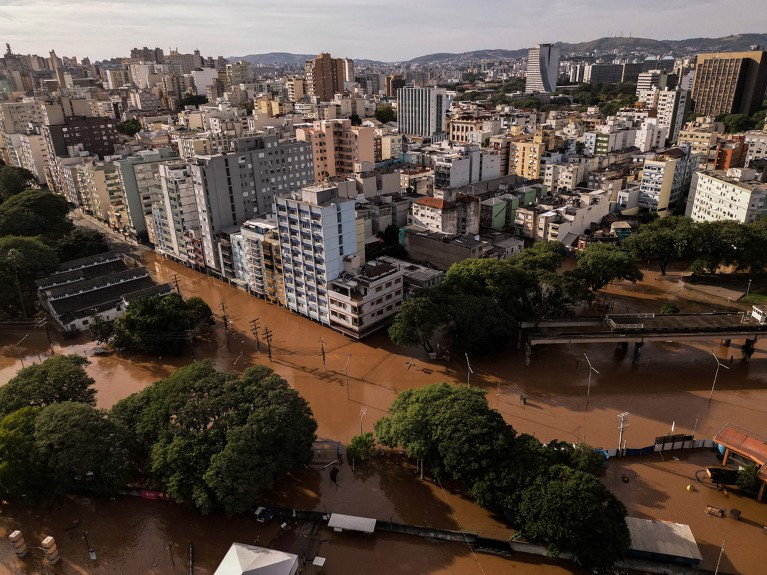
During the unprecedented floods in April and May, boats were the only means of transport in some parts of Porto Alegre.Credit: Nelson Almeida/AFP via Getty
The WHO also recommends allowing communities to help themselves by creating groups that work collaboratively to solve problems. “The more the community helps each other, the more people feel supported, which reduces rates of post-traumatic stress disorder (PTSD), for example,” Mosqueiro says. Another WHO recommendation is to offer psychological first aid, which can be done by any community member with basic training. It involves listening to the individual, without pressuring them to talk, and helping them to address immediate needs.
‘We are killing this ecosystem’: the scientists tracking the Amazon’s fading health
Another lesson from past crises is that excessive medical intervention can backfire, says Noal, who consults for governments and aid organizations such as Médecins Sans Frontières (also known as Doctors Without Borders) on the mental-health response to disasters. She says that during past events — such as a mining-dam collapse in the state of Minas Gerais in 2019 — there was an overdiagnosis of mental-health disorders in the initial period after the disaster, when such reactions should be considered normal.
As a result, people began to see themselves as traumatized victims, which can be disempowering and weaken their sense of community, she says. “When the community comes together, organizes collective efforts and demands their rights, that is also a form of mental-health action. But if you individualize suffering with a diagnosis, you assume that it’s now every person for themselves, and that’s a mistake.”
And that is why those who provide care should avoid referring to ‘symptoms’ and instead talk about ‘expected reactions’ when discussing difficulty sleeping, anxiety and other common outcomes of a traumatic event, says Noal. “We guide people to self-monitor and only seek help if the issues persist. They need to utilize their own coping strategies; otherwise, they risk becoming dependent on health-care professionals.”
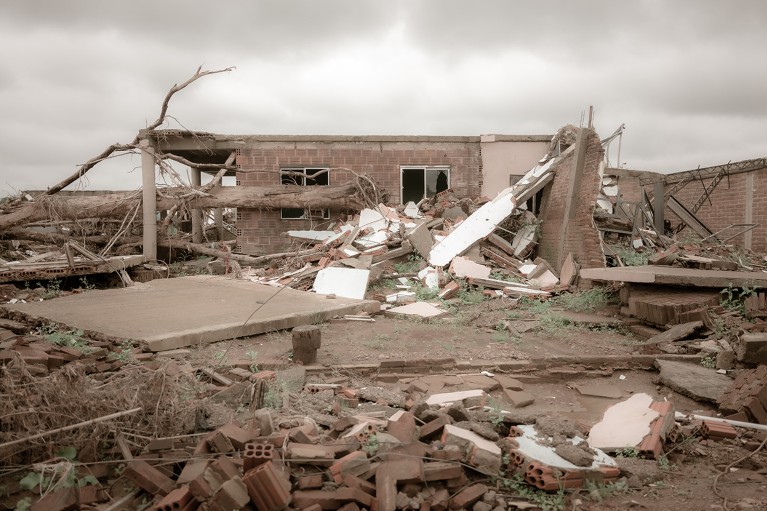
On a street along the Taquari River in Arroio do Meio, few houses remained standing after the flood.Credit: Marcio Pimenta for Nature
In the first 48 hours after a trauma, the use of benzodiazepines — commonly used to treat anxiety — is contraindicated, Hauck says. They are known to impair the consolidation of traumatic memories and increase the risk of PTSD.
It’s also important to consider that strategies and instruments created to address mental-health issues arising from disasters in high-income countries might not work in other settings. When Hauck and her colleagues tried to apply international standardized mental-health-screening questionnaires to people in shelters during the floods, they noticed that some people did not understand questions that researchers considered to be simple, but which contained words that were not easily understood by a vulnerable population with lower levels of education. “So, we need to think about how to include these people and adapt the questions,” she says.
“When we transpose instruments that are developed in the US and Europe to our context, we always wonder why it didn’t work,” says Kapczinski. Researchers in Rio Grande do Sul are now developing an app to estimate mental-health symptoms in disasters. The researchers plan to launch the app in Portuguese, Spanish and English so it can be deployed in other countries, especially in low- and middle-income ones.
Enduring trauma
Eliana Silva de Araújo had already lost her home when the May floods hit Rio Grande do Sul. Her house in the Taquari Valley region in the central part of the state was destroyed by a large flood that struck the area in September 2023. Then, in May, the school where she, her daughter and granddaughter were taking refuge was inundated, forcing them and hundreds of people who had already been displaced to relocate to a new shelter.
In Porto Alegre, many displaced people were able to return to their houses after the water receded, but in the Taquari Valley region some neighbourhoods were completely wiped out and are no longer considered safe to live in. And as a result, shelters in that area are still crowded: there simply aren’t enough houses for the displaced families.
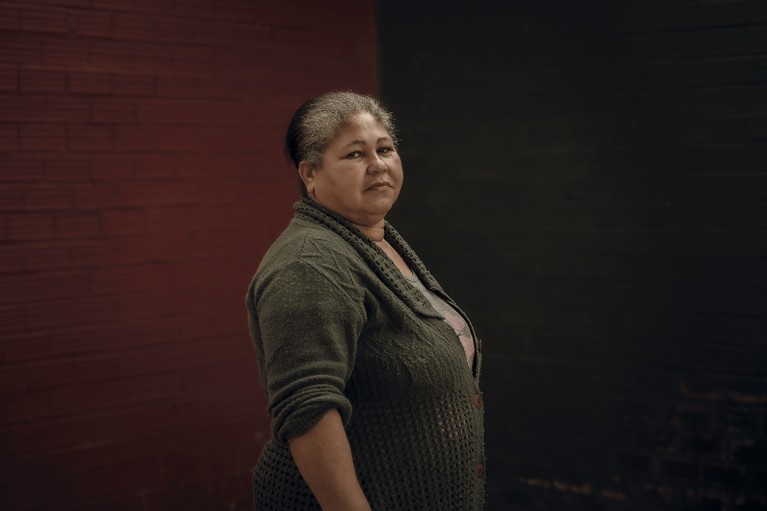
Eliana Silva de Araújo has been living in shelters with her daughter and granddaughter.Credit: Marcio Pimenta for Nature
As a microcosm of society, the shelters are affected by problems such as violence and alcohol and drug misuse, contributing to the mental-health toll of the disaster. Adding to that, Araújo says that her neighbours discriminate against her because she is from Bahia, a lower-income state in the northeast of Brazil.
“What affects me the most is not even the floods, it’s the people,” she says. “I felt really bad after the last flood because of the prejudice; I was really struggling.”
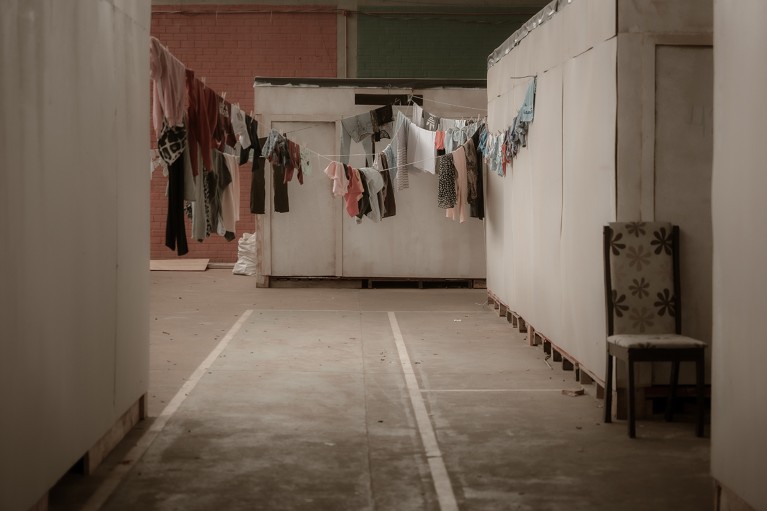
Dozens of displaced families live in this shelter in Encantado in the Taquari Valley region, where whole neighbourhoods were destroyed by flood waters.Credit: Marcio Pimenta for Nature
At one point, she had to receive psychiatric care, she says, although she feels better now and has made peace with the fact that it might be a long time before she can have her own place again.
One of the neighbourhoods wiped out by the flooding was Passo de Estrela in Cruzeiro do Sul, where Joelson de Moraes Ferreira is a psychologist at the city’s main health-care clinic. In a group therapy session with women from the community, he asked them to write down all their memories of the lost neighbourhood in a notebook.
“One of them brought up that the church where she got married and later baptized her children doesn’t exist any more. And even the photographs of these events were lost, so she is losing that memory,” he says, his voice choked with emotion.
In a workshop organized by Ferreira a few months ago, the participants were asked to share what they would like to happen to Passo de Estrela, knowing that they will not be able to live there again. “Unanimously, they said they would like to see it as a public space with parks and trees, where they could go to take walks, see friends and drink chimarrão [a regional tea].”
Gisele Dhein, a psychologist at the University of Taquari Valley who is assisting in the implementation of a mental-health response plan for the region, says that these activities foster a sense of empowerment in the community, which is crucial for rebuilding society after a disaster. “Much of the coping strategy will involve rebuilding family ties and restoring community bonds,” she says.

Rogério Rammê, an attorney and animal welfare advocate, poses with rescue dog in an animal shelter in Porto Alegre where he has volunteered.Credit: Marcio Pimenta for Nature
Researchers say that social support and resilience — the ability to adapt and recover from adversity — are important to prevent depression and PTSD after disasters. Yet, the literature in this area remains limited. So Lidia Maria Erbes, a master’s student in psychology at the University of Taquari Valley, decided to study whether people affected by the floods who had more social support and resilience developed fewer mental-health symptoms than did their peers. She created a questionnaire that is being sent out to people across the valley and hopes to have the results by the end of the year.
The goal is to assess the mental-health impact of the floods and identify potential protective factors, says Joana Bucker, Erbes’s adviser on the project. “This will allow us to think of strategies for intervention in the future,” she says.
Social support was essential for Jardim and his mother, Jurema, as they rebuilt their lives after the flood waters had drained away. When he reached out for help, 18 friends arrived one Saturday morning to form a clean-up task force. In days, the house was ready for their return. As I left their home on a rainy morning months after the flood, I noticed the vibrant foliage in their planters. When I asked if these plants had survived the floods, Jurema shook her head.
“These are new,” she said. “They were planted by our friends.”


